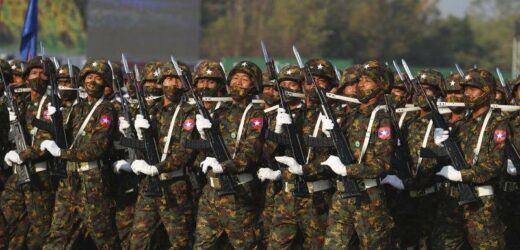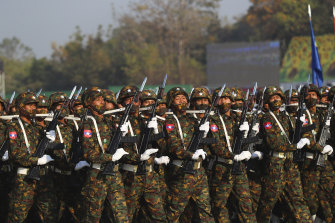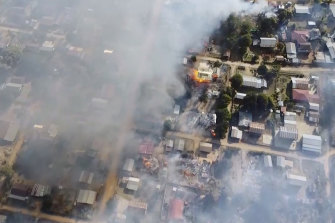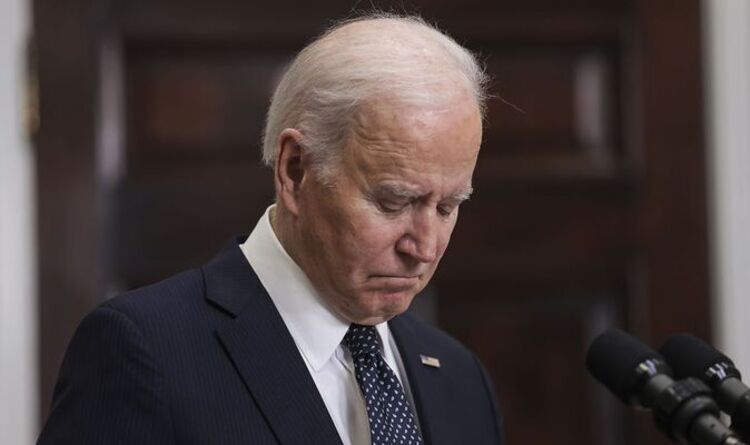Singapore: Australia has begun granting protection to defectors from Myanmar’s armed forces who have escaped the south-east Asian nation with tales of the military’s brutality.
While Russia wages a war in Ukraine that threatens to unsettle the global order, Myanmar continues to be held hostage by a junta that seized power in a coup in February last year.
Soldiers march in Myanmar’s capital Naypyitaw in February.Credit:AP
The Sydney Morning Herald and The Age have spoken to two former members of the military whose pleas for asylum have been accepted by the Australian government since January.
One ex-soldier, who joined a resistance group before fleeing to the Myanmar-Thailand border, told of how he deserted because he didn’t “accept the coup”.
“I don’t want to kill civilians and I don’t want to stand against civilians,” said the former captain, speaking on the condition of anonymity out of fear for the safety of family members who remain in Myanmar.
“There are many former soldiers here hiding [near the border]. We are not safe in Myanmar. We are a little safer here but we are stuck and we want to start a new life.”
Another, who has already been resettled in Australia with his family and also spoke on the proviso that his identity was not revealed, said there had been threats on his life even after he had fled to Thailand.
“The military junta is very cruel,” he said. “I couldn’t stay there. Before the coup I believed that our country may be peaceful but unfortunately the junta [staged] a coup.”
The United Nations this week released a report accusing the Tatmadaw, as the military is known, of potential war crimes and crimes against humanity, cataloguing atrocities including security forces’ targeting of civilians with air strikes, the burning of people to death and the use of torture.
Myanmar’s armed forces are also accused in a UN court of committing genocide during a crackdown against the Rohingya Muslim ethnic minority in western Rakhine state in 2017 which included mass killings, rape and drove more than 700,000 people out of the country to seek refuge in Bangladesh.
Dismayed by the post-coup savagery, as many as 2500 soldiers and 6000 police officers have defected, according to resistance groups inside Myanmar. An unknown number have simply deserted the military, which is said to be 300,000 strong, reportedly crossing into India as well as Thailand.
In this image taken from drone video provided by Free Burma Rangers, smoke arises from burning buildings in Waraisuplia village in Kayah State, Myanmar on February 18.Credit:Free Burma Rangers
Australia’s Department of Home Affairs said in a statement it would not comment “on the circumstances or humanitarian resettlement prospects of individuals or specific groups”.
“Each visa application is considered on its individual merit using current and comprehensive information on circumstances in the relevant country,” the statement said.
“Each applicant is also required to meet all relevant public interest criteria in order to be granted a visa.”
But Dr Tun-Aung Shwe, the Australian representative for Myanmar’s in-exile National Unity government, told the Herald and The Age he was aware of military defectors who had been accepted by Australia recently and believed such action by Western governments could ultimately help weaken the junta, which calls itself the State Administration Council (SAC).
“I was asked by the NUG [ministry of foreign affairs] to inform the Australian, New Zealand and the US governments to consider protection of the military defectors,” said Shwe, whose late father was a founding member of Myanmar’s National League for Democracy party with Aung San Suu Kyi, the country’s overthrown civilian leader.
“The break-up [of the armed forces] can only be accelerated if the international community and governments are able to provide protection for the military defectors.
“I do know of two [defectors] as well, who came to Australia via Thailand, and participated in [resistance] group activities before they came to Australia.”
He said it was important that the People’s Embrace, a collective of former soldiers who joined the civil disobedience movement and have links with the NUG, were involved in the vetting of defectors’ backgrounds.
Leading independent Myanmar analyst David Mathieson believes it is important to distinguish between defections and desertions when trying to measure the impact on the military.
“But we’re playing with so many unknown figures of military strength, size, casualties and desertions, how can anyone predict with any certainty what this all means?” he said.
“Unless [there is] defection writ large … it’s premature to trumpet the imminent collapse of the SAC.”
The Department of Home Affairs did not comment on how many political exiles or activists have been brought to Australia since the coup but government figures show 513 people from Myanmar were provided onshore protection visas between February 1 last year and January 31.
While Mathieson said it was good news that Australia was offering protection visas to defecting military personnel, he argued that needed to be augmented with more places for refugees from Myanmar’s conflicts.
“Not just prominent activists but victims of the ethnic civil war who are often neglected in the popular imagination … civilians who have been bombed out of their homes all over Myanmar,” he said.
Unlike its response to Russia’s invasion of Ukraine, the Australian government has not joined the United States, the United Kingdom and others in imposing sanctions against the regime in Myanmar.
The reluctance to take that step has coincided with the detention for more than a year of Australian economist Sean Turnell, an advisor to Suu Kyi. He is facing charges of violating state secrets that have been denounced as spurious by his supporters and the international community.
At least 1600 people have been killed by Myanmar’s security forces in the past year, and more than 12,500 have been detained, according to the latest UN report.
Get a note direct from our foreign correspondents on what’s making headlines around the world. Sign up for the weekly What in the World newsletter here.
Most Viewed in World
From our partners
Source: Read Full Article




